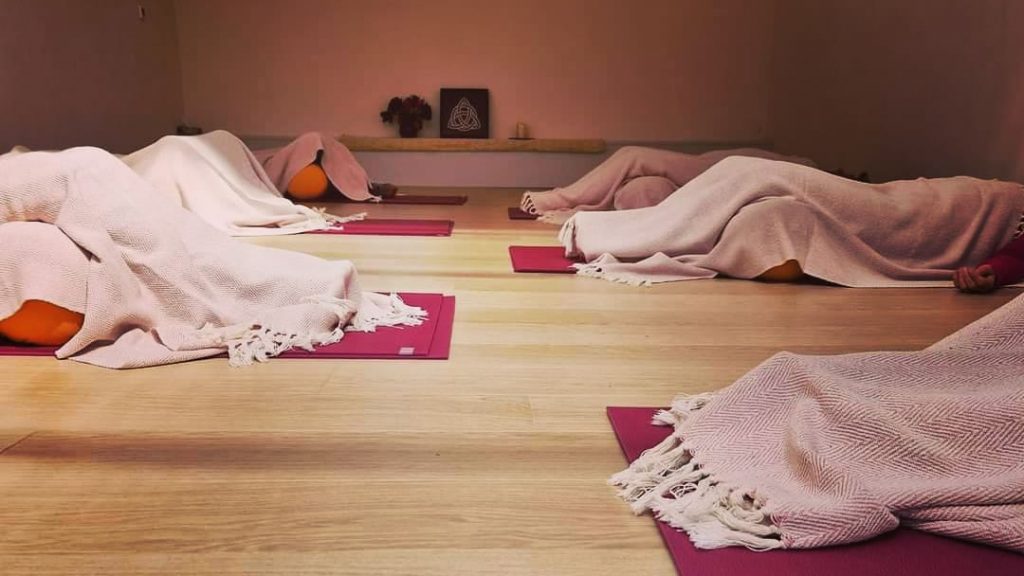
Yoga as embodied practice
note: ‘soma’ means ‘body’ in Greek
Somatics is a recent buzzword in yoga but what does it mean?
I want to let you know that it’s an approach. It’s not a particular set of moves or a school of practice, necessarily. In my 35- year experience, I’d say it’s an understanding that evolves with practice. With time and an exploring mindset, when you do yoga you discover something completely natural.
It’s a body awareness, an observation of what is going on inside. Looking to the original intentions of yoga practice – in ashrams or monasteries – holding yoga postures was a training in noticing the restrictions or flow in the body and, from there, noticing the movements of the mind, the emotions. This was a tool to self-knowledge and spiritual awareness.
So, it starts with what might seem banal, lying on the mat and invoking a conscious breath, noticing the points where the weight of your body, rests on the floor…sensing how the belly stretches as you inhale…the gurgle of your tummy as you relax…and then the peace arising, from your body, through your body but somehow from another place. Dare I say, it’s the peace that surpasses all understanding[1], an inkling of transcendence.
Science has a name for this inner observation, interoception, and studies have linked this skill with increased well-being[2]. Developments in understanding the neurobiology of trauma over the past thirty years have highlighted what yogis knew all along: practising yoga releases sorrows stored in the body. The scientist who wrote the seminal The Body Keeps the Score[3] cited yoga as the best tool for healing.
Yoga instructor makes me cringe, and I wince too at teacher. I see myself as a facilitator of a space for rest and flowing peace. Sure, I do show people techniques and an approach, but following on from newbies courses it’s increasingly about individuals owning their practice, eyes closed, with less and less guidance from me. ‘Students’ become friends and fellow-travellers.
So: somatics, an embodied approach for growth. Read on if you’d like my angle on the spirituality that evolves from this understanding.
A classic term for yoga is kriya, which means cleaning. In some ways I object to this kind of ‘ascension’ spirituality (bad to good, dirty to pure: we are ever works in progress). However, I know from my own experience that yoga facilitates a cleansing release of things we think define us: gender, age, the criticism you’ve unconsciously internalised, societal conditioning. In yoga philosophy, the deity Siva[4] represents the destruction of that which no longer serves; in faith baptism, and its renewing identity in weekly worship, symbolises the death of the old self. Letting go of this ‘small’ self and its pathologies makes space for spiritual revelation: understanding about the truth of your life. Life in general!
And that numinous sense of the transcendent I mentioned earlier. Sometimes a flash of wordless knowing is there too. The yogis called it darshan, perception of God. In Christian mysticism Julian of Norwich, a 12th century anchoress, used the lovely term oneing with God. Indeed, yoga comes from the word yoke, in other words, bringing two separate things into one. And yoga is the etymological root of one, union and the uni- prefix. That sense of oneness with something bigger than us, indeed all humanity and creation, can be life-changing if you allow.
This has been my journey with yoga. I should add that’s been done in a context of organised spirituality for good (and not always so good) guidance, and also a habit of personal reflection and reading. It’s important to have guidance, or alongsiding, you can trust on a spiritual journey.
I don’t frame what happens at VG as ‘spiritual’, but allow folk to discover it if they like. I frame it as shabbath (divine rest) and shalom (flowing peace), Hebrew words from the Judeo-Christian tradition, as these are such beautiful, evocative terms. They also make a bridge to and from Christian faith for those who are curious to travel in either direction, or want to enjoy the view some way along.
For these terms we thank a culture that began five thousand years ago to thrash out what it means to be a human living beyond basic urges of fear and anger. I could also point to s(h)avasana (laying down the body) and shanti (peace) from the culture in the Indus valley arising at a similar time. Something soothing about the shhhh at the beginning all four of these words! Shabbath, shalom, savansan, shanti.
Embodiment is the founding principle in Christian faith: Jesus, fully divine and fully human, came to show us our full divinity and full humanity. We are embodied beings, yoga has shone a path to explore both the meat and sinew, and the soul and heart.
[1] The New Testament: Philippians 4:7
[2] See this article for some references to papers https://www.theguardian.com/science/2021/aug/15/the-hidden-sense-shaping-your-wellbeing-interoception
[3] The Body Keeps the Score, Bessel Van der Kolk, 2014 based on his and others’ key research paper of 1994
[4] Sometimes the Hindu deities are confused as gods. No, they represent aspects of the one and only omniscient, omnipotent and omnipresent God. As all monotheistic faiths acknowledge, God is beyond qualities and our comprehension. We make images (literal and metaphorical) to begin to understand.